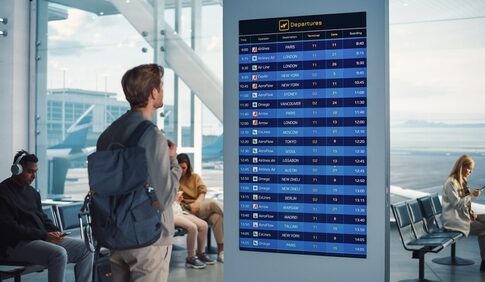American Airlines’ unexpected flight grounding due to a technical glitch underscores the integral role of technology and contingency planning in modern aviation. The ground stop lasted for an hour as management tirelessly worked to find a solution. What was the specific technical issue that caused the grounding?
Flight Grounding Incident
American Airlines halted flights nationwide early Tuesday, citing a technical problem during peak holiday travel time. This issue prompted systemwide disruptions but was short-lived due to swift intervention by the Federal Aviation Administration. The FAA responded to the airline’s request, issuing a nationwide ground stop shortly before 7 a.m. Eastern time, echoing the importance of their cooperation with airlines to ensure passenger safety and operational continuity.
The grounding occurred at a time when American Airlines, like other carriers, anticipated a significant increase in passenger volume. The Transportation Security Administration expected to screen 40 million travelers over the holiday period, making the timing of this disruption particularly critical. Thankfully, the grounding lasted just one hour, minimizing extensive travel delays and cancellations that could have affected holiday plans for millions.
BREAKING: FAA just announced that American Airlines nationwide groundstop is cancelled.
Hurry up and get home if you are flying before this changes again.
pic.twitter.com/yMfqresORW— Gunther Eagleman™ (@GuntherEagleman) December 24, 2024
Impact and Response
Despite the quick resolution, the grounding highlighted vulnerabilities within the aviation industry, particularly during the busiest travel seasons. Contingency plans and technology reliability are increasingly vital as the industry grapples with an uptick in technical failures. American Airlines’ incident serves as a reminder of past disruptions, such as Southwest Airlines’ Christmas debacle in 2022, which incurred over $1 billion in costs and fines. Unlike those, American Airlines managed to quickly regain normal operations.
“Just before 7 a.m. Eastern time, the Federal Aviation Administration ordered all American Airlines flights grounded in the U.S. at the airline’s request,” said the Federal Aviation Administration.
The decision not to disclose the specific technical malfunction reflects the sensitivity around technological vulnerabilities and consumer confidence in aviation safety. As airlines continue to modernize their operations, ensuring robust emergency protocols and effective technology management remains a top priority to avoid further disruptions.
Where is Mayor Pete?@SecretaryPete
Christmas Eve Ground stop for Nation’s largest Airline due to IT issues!
🧐American Airlines grounds flights nationwide amid 'technical issue,' FAA and airline say – ABC News via @ABC – https://t.co/b4xYGQX1Kc
— 🐝 for Brenda (@fightfite) December 24, 2024
Lessons and Future Preventions
This incident underlines that while technology offers many benefits to the aviation sector, it also poses risks that need to be proactively managed. Airlines must develop robust contingency and recovery plans to mitigate the impacts of technical glitches. The cooperation observed between American Airlines and the FAA sets a precedent for effective collaboration in dealing with emergencies, underscoring the necessity for readiness in safeguarding against unforeseen disruptions.
The aviation industry must remain vigilant as they rely on increasingly complex systems. The capability to act swiftly and the presence of robust contingency plans ensure passenger safety and operational efficiency during unavoidable technological interruptions, exemplifying the importance of preparedness in today’s highly interconnected world.


